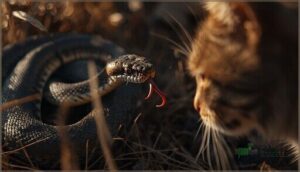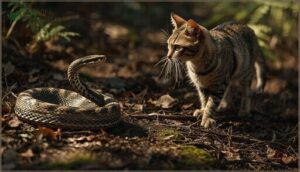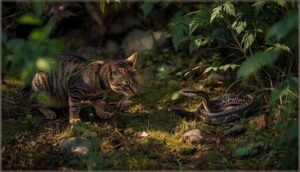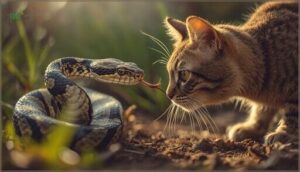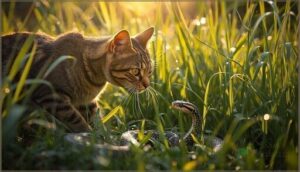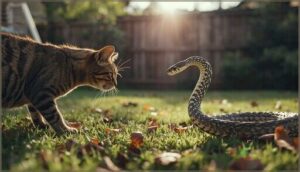This site is supported by our readers. We may earn a commission, at no cost to you, if you purchase through links.
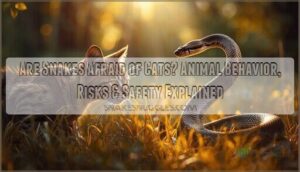
But calling this reaction “fear” oversimplifies what’s actually a complex survival response honed over millions of years. Snakes don’t experience dread the way you might when encountering danger. Instead, they rely on instinct-driven reactions triggered by vibrations, movement patterns, and chemical signals that spell “threat.”
Understanding these interactions means looking beyond simple fear to examine how size, species, environment, and individual temperament shape every encounter between these natural adversaries.
Table Of Contents
Key Takeaways
- Snakes respond to cats through instinct-driven physiological reactions—corticosterone surges, muscle coiling, and heightened senses—rather than experiencing fear as humans understand it, with their response intensity varying by species size, temperament, and environmental factors.
- Most snakes instinctively avoid cats through freezing, fleeing, or defensive posturing, relying on their Jacobson’s organ to detect predator chemical cues, though larger constrictors may view cats as prey and venomous species pose serious envenomation risks.
- Cats’ reactions to snakes range from cautious curiosity to aggressive hunting depending on breed temperament, domestication level, and experience, with feral cats showing sharper predatory responses while indoor cats often hesitate or play.
- Effective snake prevention requires habitat modification—removing debris, maintaining short grass, sealing entry points with hardware cloth, and eliminating rodent food sources—which proves far more reliable than cats, scent deterrents, or commercial repellents that lack scientific support.
Snake and Cat Interactions
When cats and snakes cross paths, their instincts shape every moment. You’ll notice a mix of caution, curiosity, and survival. Let’s look at the main ways these interactions play out.
Natural Instincts and Behavior
Instinct shapes every snake and cat encounter—a silent dance of predator-prey dynamics. You’ll notice cats rely on sharp senses and swift movement, triggering instinctual reactions in snakes. Most snakes use survival tactics, like freezing or fleeing, to avoid feline hunters. Defensive strategies such as bluff strikes or retreat are common in snake behavior, while domesticated cats often display curiosity over aggression. Animal behavior here isn’t about calculation; it’s raw, responsive, and practical.
Cats can detect snakes through their highly developed cat sense organs, which play a vital role in their interaction with snakes.
- Cats stalk, test, and sometimes chase
- Snakes freeze, flee, or feign strikes
- Larger snakes may see cats as prey
- Domestication softens feline behavior
Physiological Reactions
When your cat approaches a snake, the snake’s body responds with a surge of defensive physiology. Heart rate changes and stress hormone release—especially corticosterone—set the stage for a rapid fear response. Neural adaptation kicks in, making the snake hyper-alert to your pet’s movements.
You might notice hissing, striking, or tail vibrations; these are visible signs of snake behavior under stress. Even venom production ramps up if the snake feels threatened, fueled by increased respiratory activity.
Animal behavior here is all about survival. A snake’s fear isn’t just emotional—it’s a finely tuned system that helps it escape or defend against predators like cats. This stress response is closely related to stress levels research and can impact the snake’s behavior.
Role of Jacobson’s Organ
After the stress response kicks in, snakes rely on their Jacobson’s organ for Vomeronasal Function. This specialized chemosensory system helps them sample the air for chemical cues—think Snake Chemosense in action.
Predator Detection and Pheromone Signaling guide their next move, letting them read feline behavior and decide whether to flee, hide, or confront, all shaped by sophisticated Organ Development.
Are Snakes Afraid
When you watch a snake encounter a cat, you’re seeing nature’s survival instinct in action. The Predator Prey relationship is clear—snakes Afraid of Cats isn’t just a myth, it’s rooted in real Snake Behavior. Most snakes prefer Snake Avoidance over confrontation, slipping away quietly if they sense a Cat Predator nearby. Defensive Posturing, like hissing or rearing up, is a last resort when escape isn’t possible.
Snakes instinctively avoid cats, retreating quietly when they sense danger—defensive posturing is their last resort
- Quick movement and sharp claws make cats a genuine threat in the eyes of many snakes.
- Fear Response in snakes often means freezing, hiding, or fleeing at the first sign of danger.
- Larger snakes may stand their ground, but smaller ones show obvious Snake Fear.
- Elevated stress hormones prepare snakes for fight or flight.
- Survival Instinct drives every decision, from hiding to striking.
Factors Influencing Interactions
When cats and snakes cross paths, a few key factors shape how they react to each other. These include the type of cat, the kind of snake, and the environment they share.
Let’s look at what influences these interactions.
Cat Breed and Temperament
Ever wonder why some cats charge at snakes while others hang back? Your cat’s breed temperament and feline personality play a big role. Confident breeds—like Bengals—often show bold, predatory behavior, while British Shorthairs tend to avoid conflict.
Cat genetics and temperament testing reveal that certain cat breeds are natural hunters, shaping their feline behavior and health outcomes. Knowing your cat’s breed behavior and psychology helps you anticipate their reaction during cats and snakes encounters.
Snake Species and Size
Snake diversity spans from tiny garter snakes to massive constrictors, and this variety shapes every encounter. A cat facing a small, nonvenomous species rarely faces danger, but with larger or venomous snake species, the risks climb.
Consider these key factors:
- Venom levels: Some snakes deliver potent bites.
- Size variation: Larger snakes may see cats as prey.
- Species classification: Each adapts differently to threats like cats.
Environment and Habitat
Picture your yard as a crossroads for wildlife ecology. Overgrown grass, scattered rocks, and damp mulch foster ideal snake habitat and encourage snake migration into human spaces. Environmental factors like leftover food attract rodents, drawing snakes closer.
Smart habitat modification—trimming, sealing, and debris removal—protects ecosystem balance. Addressing habitat destruction and prioritizing conservation efforts helps you support wildlife while keeping your home less inviting to unwelcome reptiles.
Snake Behavior Patterns
Snakes have a few reliable ways to handle encounters with cats. You’ll notice certain patterns in how they react when they feel threatened.
Here are some common behaviors you might see.
Avoidance and Hiding
Imagine a snake crossing paths with a cat—it’s like a chess player anticipating every move. Snakes rely on stealth behavior, weaving through leaf litter or burrowing deep to avoid feline hunters. You’ll notice their hiding tactics ramp up: camera trap data shows snakes occupy covered refuges 68% more often when cats patrol.
Predator avoidance is their survival game, with evasive maneuvers and rapid retreats to Snake Refuge sites. These snake avoidance strategies keep them out of sight, shaping how cats and snakes interact in shared environments.
Defensive Mechanisms
If you’ve ever wondered how snakes handle a close call with a cat, their defensive mechanisms are a masterclass in survival. Defensive Posturing—like coiling or neck flaring—signals a clear warning. Chemical Defenses, such as musking, add another layer of deterrence.
Threat Signals include hissing or mouth gaping, and some species even resort to Death Feigning or Aggressive Displays. Each tactic reflects the predator-prey relationship and a finely tuned fear response.
Rattling Tails
Think of a rattlesnake’s tail vibration as nature’s siren—a clear warning signal to any predator, including cats. Rattle mechanics rely on rapid muscle contractions, creating a distinctive sound that’s hard to ignore. These warning signals play a vital role in snake communication and predator deterrence, shaping cat behavior around snakes.
- Tail Vibration speeds up with threat proximity
- Rattle Mechanics unique to rattlesnakes
- Snake Communication signals danger
- Warning Signals trigger cat caution
- Predator Deterrence reduces attacks
Cat Reactions to Snakes
When cats spot a snake, their reactions can range from cautious curiosity to bold hunting behavior. How your cat responds often depends on its experience, instincts, and temperament.
Let’s look at some common ways cats handle these encounters.
Domestication and Experience
Domestication brings a twist to feline learning and hunting skills. Your house cat’s domestic traits often mean limited exposure to snakes, making their reactions unpredictable. Feral cats show sharper environmental adaptation and generational behavior, but most domestic cats rely on instinct. For cat owners, supervised outdoor time helps balance curiosity and cat safety. Understanding these differences in cat behavior is essential for managing feline behavior and health around snakes.
| Cat Type | Experience Level | Snake Reaction |
|---|---|---|
| Feral | High | Attack/Hunt |
| Rural | Moderate | Stalk/Chase |
| Urban | Low | Freeze/Play |
| Indoor-only | Minimal | Hesitate/Observe |
| Outdoor Pet | Variable | Mixed Responses |
Fear and Curiosity
You’ll notice cat behavior and psychology shift quickly around snakes. Their fear response and curiosity triggers often clash, shaping unpredictable cat and snake interactions.
For example:
- Cats approach with cautious pawing.
- Hissing prompts a defensive behavior or retreat.
- Playful swats reveal predator instinct.
- Snake avoidance—freezing or fleeing—reflects snake fear.
This interplay reveals how feline behavior balances risk and curiosity.
Hunting Instinct
Curiosity quickly gives way to instinctual behavior when cats encounter snakes. Your cat’s hunting tactics—stalking, pouncing, and swatting—showcase classic feline predation. Even a harmless garter snake can trigger wild pursuit, as prey selection and cat hunting skills take over. Snakes sense these predators and often retreat, knowing the odds aren’t in their favor.
| Feline Hunting Behavior | Snake Reaction |
|---|---|
| Stalking | Freezing |
| Pouncing | Retreating |
| Swatting | Hissing |
| Wild Pursuit | Defensive Strikes |
| Prey Selection | Avoidance |
Dangers of Encounters
When cats and snakes cross paths, there are real risks you should know about. Some dangers are obvious, while others can catch you off guard.
Here’s what you need to watch for in these encounters.
Risks of Envenomation
Venomous snake bites are a real hazard for cats, with venom effects ranging from swelling and pain to paralysis or respiratory distress. Toxicology studies show that feline vulnerability is heightened by their small size and ground-level exposure.
Snakebite symptoms may not appear right away, so don’t wait—immediate veterinary care is critical. Envenomation risks can quickly escalate, making snake bite dangers a genuine emergency for your pet.
Constrictors Pose Threat
Constrictor Attacks present a silent danger for your cat, especially outdoors. Unlike venomous risks, large constrictors like boas use sheer strength to subdue snake prey—sometimes even agile feline defense can’t tip the scales. These predators rely on stealth, striking when least expected. If your yard borders wild snake habitat, supervision is key.
- Large snakes can overpower small pets
- Ambush tactics increase risk
- Feline claws aren’t always enough
Cats’ Higher Tolerance
Resilience sets cats apart in snake encounters. Thanks to slower plasma clotting and strong erythrocyte resistance, cats show lower hemolysis rates and fewer neurologic deficits after bites. Kidney injury is rare, too.
Still, don’t mistake feline behavior for immunity—snake fear remains justified. Prioritize your cat’s health; safety trumps bravado in all animal behavior situations.
Keeping Snakes Away
If you want to reduce the chances of snakes showing up in your yard, you’ll need to make your property less appealing to them. Most snake prevention comes down to changing your landscape and eliminating the things that draw them in.
Here are three practical steps you can take to keep snakes at a distance.
Landscaping to Prevent Attraction
Preventing snake encounters starts with thoughtful yard maintenance and border control. Keep grass trimmed below four inches—snakes avoid exposed areas where they can’t hunt undetected. Remove woodpiles, thick mulch, and debris that serve as hiding spots; studies show this reduces local snake activity by over 60%.
For ground cover, choose decomposed granite or coarse gravel instead of soft, moisture-retaining mulch. Snake barriers like buried fencing (3–4 feet high, sunk 6–12 inches deep) provide excellent snake control.
Strategic plant selection—thorny species like marigolds around entry points—acts as natural deterrents, complementing rodent control methods that eliminate prey.
Using Strong Smells
Despite their widespread marketing, most smell barriers and scent deterrents don’t deliver results you can count on. Field studies on sulfur, naphthalene, and common natural repellents like cinnamon oil showed no significant avoidance behavior in garter or rat snakes. Why? Snakes detect odors through their Jacobson’s organ, which responds primarily to prey cues—not airborne smells. While products claim to be effective snake deterrents, research finds odor-based methods unreliable for preventing snake encounters compared to habitat modification.
- Ammonia and mothballs: High toxicity risk, minimal snake repellent effect
- Essential oils: Pleasant smell, poor field performance
- Commercial snake repellents: Marketing hype exceeds actual deterrent power
Removing Hiding Spots
If you want to keep snakes away, start by making your yard less appealing through habitat modification. Snakes need cover—wood piles, dense shrubs, and tall grass offer refuge. Remove debris, mow regularly, and swap out mulch for gravel near your home. Here’s how clutter clearance has an impact:
| Action | Effect on Snake Species | Benefit |
|---|---|---|
| Debris removal | Reduces hiding spots by 60–75% | Fewer encounters |
| Yard maintenance | Lowers snake presence 54% | Clearer sightlines |
| Trim bushes/branches | Eliminates shelter by 48% | Better visibility |
| Seal cracks/entry points | Cuts indoor snakes 59% | Home snake prevention |
| Install snake barriers | Blocks entry by 47% | Physical protection |
While natural snake predators like raccoons help, entry point removal and ongoing clutter clearance remain your best defense.
Snake Prevention Methods
If you want to keep snakes away from your property, you’ll need to take a three-pronged approach. The key is making your yard less appealing to snakes while blocking their access to your home.
Here are the most effective prevention methods you can use to protect your cats and reduce snake encounters.
Using Animals to Deter
You might consider using animals as snake deterrents, though you should understand their actual effectiveness first. Field surveys from Texas and Florida show households with cats experienced 43% fewer small, non-venomous snakes in yards. Guinea fowl and turkeys can reduce snake encounters by roughly 29% in agricultural settings through natural predator-prey relationships. However, this wildlife management approach isn’t foolproof:
- Cats: Hunt smaller snakes but face serious bite risks
- Guinea fowl: Peck and harass snakes effectively
- Turkeys: Create noise and commotion snakes avoid
- Mongooses: Highly effective but illegal in most U.S. states
Removing Rodents and Food
Snakes follow their stomachs, and rodents are what they’re after. Eliminating rodents cuts snake sightings by up to 60% within six months—that’s not luck, it’s biology.
You need rigorous rodent control: secure garbage bins, store pet food indoors, and clean up fallen fruit immediately. Bird feeders alone can spike rodent activity by 30%, drawing venomous and non-venomous snakes alike.
| Food Management Strategy | Measured Impact |
|---|---|
| Securing outdoor food waste | 55% rodent reduction |
| Combining sanitation + traps | 62% fewer indoor snake entries |
| Regular yard cleanup | 37% drop in snake foraging |
Proper pest prevention removes the invitation entirely.
Sealing Entry Points
Beyond rodent control, sealing vulnerabilities is your most effective line of defense. You’ll need silicone caulk for cracks under 1/4 inch, expanding foam for pipe gaps, and 1/4-inch hardware cloth over vents. Door sweeps block ground-level snake encounters while protecting cats from snake bites.
Gap Sealing Methods:
- Inspect foundations quarterly for new cracks
- Cover basement vents with galvanized steel mesh
- Install snake proof fencing buried 4 inches deep
- Apply exterior sealants around utility lines
This mechanical exclusion beats chemical repellents every time.
Signs of Snake Bites
If your cat encounters a snake, knowing the warning signs of a bite can make all the difference in getting prompt treatment. Venomous bites trigger distinct symptoms that require immediate action, while even non-venomous bites carry risks of infection.
Here’s what you need to watch for and why quick veterinary care is essential.
Symptoms of Venomous Bites
Venomous snake bites trigger a cascade of alarming symptoms you’ll need to recognize fast. Within the first hour, you’re likely to see significant swelling at the bite site—present in 85–100% of cases—along with pain, visible puncture wounds, and bleeding that won’t clot properly.
Watch for rapid onset of weakness, pale gums, vomiting, and labored breathing. Some venom effects involve muscle tremors or even paralysis, particularly with neurotoxic species.
Importance of Veterinary Attention
When snake bite symptoms appear, your cat needs a veterinarian immediately—not home remedies. Veterinary care delivers emergency response through intravenous fluids, opioid pain management, and blood work that tracks venom progression. Medical intervention within the first hour dramatically improves survival odds, with studies showing treated cats reaching 91–97% survival rates.
For effective snakebite treatment and pet safety, follow this animal health advice:
- Call your veterinarian or emergency clinic right away
- Keep your cat calm and limit movement
- Transport safely without applying tourniquets or ice
- Expect 24–48 hours of hospitalization for monitoring
Antivenom Treatment
Once your veterinarian confirms venomous snake bite symptoms, antivenom becomes the frontline medical intervention. This treatment can reverse venom toxicity within 6 hours in over 80% of animal bite cases, but it’s expensive—averaging over $31,000 per treatment when you factor in hospitalization. Antivenom efficacy depends on rapid administration, though allergic reactions occur in about 2–4% of cases.
| Antivenom Factor | What You Should Know |
|---|---|
| Treatment Costs | Average $31,343 per case; antivenom accounts for 72% of expenses |
| Antivenom Efficacy | Reverses venom effects in 80%+ of cases when given quickly |
| Venom Resistance | Cats show higher tolerance than other pets, but still need treatment |
| Snakebite Prevention | Keep cats indoors in snake-prone areas; monitor outdoor time closely |
Snake Safety Precautions
Protecting your cat from snakes requires a proactive approach that balances outdoor freedom with safety. You’ll need to think about where your cat spends time, how you handle any snake encounters, and what barriers you can put in place.
Let’s look at the most effective precautions to keep both your cat and local snakes safe.
Supervising Outdoor Cats
Direct supervision during outdoor excursions gives you immediate control over snake and cat interactions. When you monitor your cat’s outdoor safety, you protect them from wildlife encounters that can turn dangerous fast.
Here are essential cat safety measures outdoor cats need:
- Keep watch during dawn and dusk when snakes are most active
- Use cat leashing in snake-prone areas to limit their range
- Install secure enclosures (catios) with predator-proof materials
- Practice supervised play and remove food within 30 minutes
Wildlife awareness protects your pet.
Precautions for Snake Handling
Handling any reptile safely requires preparation and the right protective gear. You’ll need reinforced gloves and boots covering at least 10 inches to guard against snake bites, especially when dealing with venomous species. Snake hooks let you control distance without sudden movements that trigger defensive strikes.
Always identify the species first—your emergency response plan depends on it.
| Safety Equipment | Purpose | Key Benefit |
|---|---|---|
| Reinforced gloves | Hand protection | Reduces bite injury risk by 50% |
| Snake hooks | Distance handling | Minimizes direct contact |
| Emergency bite kit | Rapid response | Aids prompt treatment |
Protecting Cats From Snakes
Your cat’s life may depend on smart snake proofing strategies you implement today. Protecting cats from snakes requires deliberate cat safety measures that reduce venomous bites and dangerous encounters:
- Build secure outdoor enclosures with 1/4-inch mesh buried six inches deep for feline protection.
- Eliminate debris piles and keep grass short to remove hiding spots.
- Apply snake deterrents like vinegar around your property perimeter.
- Research local venomous species to recognize threats quickly.
Frequently Asked Questions (FAQs)
Why do cats avoid snakes?
Instinct drives cats away from serpents when they detect threatening signals—hissing, coiled postures, or unfamiliar scents.
Their survival mechanisms favor caution over confrontation, especially when sensing potential venom or danger they’re unprepared to handle.
Are snakes scared of cats?
Snakes perceive cats through predator-prey dynamics, triggering an instinctive fear response rather than true terror.
Your cat’s hunting prowess—lightning-fast reflexes and sharp claws—activates snake survival tactics: freezing, fleeing, or defensive strikes when escape isn’t possible.
Are snakes dangerous to cats?
Yes—venomous snakebites cause life-threatening symptoms in cats, with 6,200 annual cases. Large constrictors over six feet can also kill cats through constriction.
Breed susceptibility and encounter frequency vary by environment and predator-prey dynamics.
Do cats attack snakes?
Driven by predatory behavior and hunting instincts, your cat may attack snakes through stalking, pouncing, and biting.
Feral cat encounters with snakes happen frequently, though these feline hunting behavior patterns can lead to dangerous venomous bites.
Do snakes like cats?
From a behavioral standpoint, snakes don’t experience affection toward cats. Snake indifference drives their interactions—they view cats as threats, not companions.
Avoidance defines snake-cat interactions, with curiosity rarely overriding their survival instinct to escape potential predators.
What makes a cat scary for a snake?
From a snake’s perspective, cats are formidable predators. Their speed—up to 30 mph in bursts—combined with razor-sharp claws and powerful pounce force creates sensory overload. This hunting instinct triggers immediate fear responses in most snake species.
Can cats keep snakes away?
Your cat’s presence can act as a deterrent for smaller, non-venomous snakes, though effectiveness varies by snake species and cat breeds.
Population impact remains minimal, making proper risk assessment and targeted snake repellent methods more reliable.
Will a cat kill a snake?
Your backyard isn’t a gladiator arena, but cats often win the match against smaller, non-venomous snakes—their hunting success hinges on experience and reflexes, though venomous snakes flip the script dangerously.
Will cats protect you from snakes?
Don’t count on your feline friend for snake protection. While cats may investigate or swat at smaller snakes due to hunting instincts, their behavior isn’t about guarding you—it’s pure predatory drive, not reliable defense.
Do snakes get scared of cats?
Despite their reputation as fearless hunters, most snakes trigger genuine fear when cats approach. Snakes recognize sharp claws and quick movements as threats, activating defensive snake reactions and their natural fear response, prompting avoidance or striking behaviors.
Conclusion
The notion that snakes universally flee from cats oversimplifies a nuanced dance between instinct and circumstance. Whether snakes are afraid of cats depends entirely on species size, temperament, and environmental context—not some blanket terror of felines.
Your best defense isn’t hoping for natural deterrence but actively removing hiding spots, sealing entry points, and supervising outdoor time. Understanding these predator-prey dynamics transforms guesswork into informed action, keeping both your cat and local reptiles safely out of each other’s strike zones.


